|
a - f |
g - p | q
- z
|
11
x 14,
James Benning
1976, 83:00
James Hoberman chose 11 x 14 as one of the top ten films of the
seventies (Film Comment, January 1980) and later wrote in The
Village Voice: "One of the most praised American avant-garde films
of recent years, James Benning's 1976 feature is a laconic mosaic
of single-shot sequences, each offering some sort of sound/image
pun or paradox. At once a crypto-narrative with an abstract, peekaboo
storyline and fractured, painterly study of the midwestern landscape,
11 x 14 points toward the creation of a new, nonliterary but populist
cinema."
http://www.canyoncinema.com/B/Benning.html
|
|
330
Miles Toward Justice, Keith McManus
2003, 58:00
http://www.keithmcmanus.com/
In
April of 2003, farmworkers marched from New York City and Seneca
Falls to the state capitol, Albany, to demand a change in the
archaic state laws that have excluded them from basic rights and
protections since the 1930's. They were joined by their supporters,
including union members, students, and people of faith. This march
is used as a narrative base to tell the story of several individuals
living this struggle.
|
|
(The)
Amazing Mothman, Bill Brown
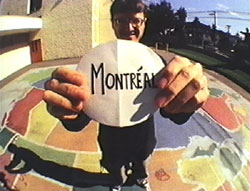
Bill
Brown creates idiosyncratic documentaries that explore the relationship
between people and the places in which they live. His four films,
including Roswell, Hub City, Confederation Park and Buffalo Common
have won awards at the Ann Arbor Film Festival, Kansas City Jubilee,
and the Magnolia Independent Film Festival. In 1997-98 he was
awarded a Fulbright Scholarship to study the Trans-Canada Highway.
http://www.channel.creative-capital.org/grantee_147.html
|
|
Atomic
Journeys: Welcome to Ground Zero, Pete Kuran
2001, 60:00
This hour-long documentary about off-site nuclear tests includes
recently declassified film from the government that depicts the
underground explosions in Mississippi, Colorado, New Mexico and
Alaska, some as recently as the 1970s. Like most of the other
Pete Kuran productions on atomic history, the film is narrated
by William Shatner, with an original score performed by the Moscow
Symphony. This film also includes interviews and images from the
CLUI.
http://www.clui.org/clui_4_1/index.html
|
|
Belfast,
Maine, Frederick Wiseman
1999, 248:00
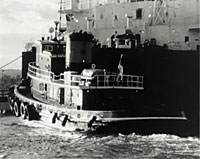
http://www.zipporah.com/
http://www.zipporah.com/31.html
http://www.salon.com/people/conv/2002/01/30/wiseman/
http://www.walkerart.org/calendar/0311/details/Wiseman.html
BELFAST,
MAINE is a film about ordinary experience in a beautiful old New
England port city. It is a portrait of daily life with particular
emphasis on the work and the cultural life of the community. Among
the activities shown in the film are the work of lobstermen, tug-boat
operators, factory workers, shop owners, city counselors, doctors,
judges, policemen, teachers, social workers, nurses and ministers.
Cultural activities include choir rehearsal, dance class, music
lessons and theatre production.
"Belfast,
Maine conveys a deeply emotional sense of place, season and time
of day. In contrasting the breathtaking landscape with the troubled
lives of many of those living there, it reminds us that the fleeting
beauties of the natural world the simple pleasures available to
all are among life’s deepest consolation." - Stephen Holden, The
New York Times
|
|
Beyond
Measure: Appalachian Culture and Economy, Herb E. Smith
1994, 58:00
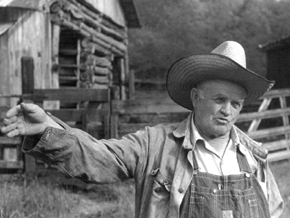
http://ns.appalshop.org/film/film.php?filmid=78
"It's
going to be pretty hectic back in here, once this coal gets gone."
- Harding Ison
There
is a constant tension between the forces of an ever changing economy
and need to have stable communities. All communities must have
an economic base, yet changes in economic conditions can devastate
a community. As technologies change, workers can lose their jobs
and whole communities can be left without a stable source of income.
Beyond Measure looks at specific examples of people wrestling
with these challenges, the people of the Appalachian Mountains,
the
people of the Appalachian coalfields.
People
in the heart of the Appalachian Mountains know how to survive
hard times. Currrently thousands of coal miners are losing their
jobs as a wave of newer and bigger machine moves through the coalfields.
As jobs are lost, communities face an uncertain future. Beyond
Measure places the present challenges in a larger historical context
and document efforts of citizens to rebuild their communities.
The beauty and challenges of living in the mountains are shown
as the people describe their daily lives. Rather than a disembodied
voice narrating the film, we hear the words and clarity and depth
which comes straight from their own experiences. They describe
how the mutual aid and suppot of extended families and attachments
to the land are more important than the things economists usually
measure.
|
|
BIT
Plane, Bureau of Inverse Technology
1999, 13:00

http://www.vdb.org/smackn.acgi$tapedetail?BITPLANE
http://www.bureauit.org/bitindex.html
BIT
plane is a highly compact spy plane, wingspan 20 inches, radio-controlled,
video-instrumented and deployed over areas of scenic interest.
Due to its refined dimensions, BIT plane is able to enter territory
inaccessible to other aircraft. Pioneering flight: in an aerial
reconnaissance over the Silicon Valley, California 1997, BIT plane
flew solo and undetected into the glittering heartland of the
Information Age. Video generated in this exercise includes footage
retrieved over no-camera zones Apple, Lockheed, Nasa Ames, Netscape,
Xerox Parc, Interval Research, Atari, Hewlett Packard, Oracle,
Yahoo, SGI, Sun Microsystems.
|
|
Bontoc
Eulogy, Marlon E. Fuentes
1995, 56:00
http://www.naatanet.org/apatv/archives/BontocEulogy.html
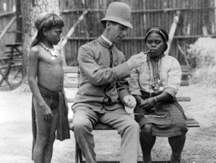
The
1904 St. Louis World's Fair brought many wonders to thousands
of visitors, including a live exhibit of "primitive"
tribesmen from what is now known as the Philippines. What happened
to these people, or "specimens" as they were called,
and what became of their "contribution" to anthropological
science? Their compelling story is revealed by a present-day Filipino
American, whose grandfather Markod was exhibited as an Igorot
warrior at the Fair. Part truth, part fantasy, Bontoc Eulogy combines
archival photos and footage with contemporary live-action scenes,
exploring the complex psychology behind a unique and celebrated
event -- the turn-of-the-century World's Fair -- where race, science,
and politics intertwined in a manner and on a scale never to be
seen again. A 1996 International Documentary Association (IDA)
Award nominee.
|
|
Borealis,
Steina Vasulka
1993
http://www.c3.hu/scca/butterfly/Vasulkas/synopsis.html
http://www.vasulka.org/Steina/Steina_Borealis/Borealis.html
BOREALIS
is a projected video environment with two video and four audio
channels of presentation. The projectors, laid on their sides,
provide an upright ratio for large projection screens, hung vertically
in the exhibit space. Half-transparent mirrors, are placed in
the projection pathway splitting and directing the image onto
two additional screens, now four in total. The screens are made
of translucent material that shows images with equal intensity
on both surfaces, front and rear. The result is eight vertically
viewed large images, placed in an irregular pattern, which harmonizes
with the exhibition space. The program comes in the form of a
ten-minute repeating loop. Each of the two video laser disc players
provides one video and two audio sources to the two projectors
and four speakers. At the end of each cycle, a laser disk synchronizer
aligns the two video players for a repeat performance.
Steina's
means are simple. She takes stunningly beautiful yet turbulent
clips of nature in her native Iceland, enlarges them, then turns
them on end, literally and figuratively, so that they may be experienced
as living abstractions on a scale equal to that of the human body.
The effect is to tear them from their entrenchment in the clichÇ
so they may be perceived free from the drag of representational
history. Nature, having somehow survived the twentieth century
onslaught of archaic industrial insults, speaks in the only way
it can, through stormy electronic images by an artist with roots
both in urban culture and in a remote land still precariously
preserved in ice. - LANE BARDEN
|
|
Bouquets
1-10, Rose Lowder
1994-1995, 11:00, 16mm, color/si

BOUQUETS 1 to 10 consists of ten one-minute films covering a variety
of subjects. After working for nearly two decades on frame-by-frame
in-the-camera structuring devices (my films PARCELLE, RUE DES
TEINTURIERS, CHAMP PROVENÇAL, Retour d'un rep?re, Retour d'un
repere composé, LES TOURNESOLS, IMPROMPTU and QUIPROQUO develop
such processes), I managed in this series to abandon the stationary
camera while still retaining what I consider a necessary graphic
coherence. The procedure is too intricate to describe briefly
but basically it entails using the film strip as a canvas with
the freedom to film frames on any part of the strip in any order,
running the film through the camera as many times as needed.
Each bouquet of flowers is also a bouquet of frames mingling the
plants to be found in a given place with the activities that happen
to be there at the time.
Note: Each BOUQUET is one minute, but film starts and ends with
three seconds of black; six seconds of black in between each BOUQUET.
|
|
Buffalo
Common, Bill Brown
2001, 23:00, color
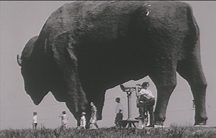
In
a continuation of his series of short poetic essay films exploring
disappearing places and cultures, filmmaker Bill Brown visits
the barren plains of North Dakota, where in the summer of 1999
the American government started to dismantle 2500 former ICBM
missile silos. Winner of the Festival Award at the 2001 New York
Underground Film Festival.
|
|
Caesar's
Park, Sarah Price
2000, 65:00, color
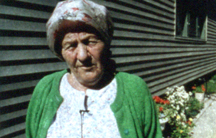
In
1995, filmmaker Sarah Price (producer of AMERICAN MOVIE) moved
to Caesar's Park, a closely settled, working-class section of
Milwaukee. While getting to know her neighbors, Price filmed the
folks next door as they followed their routines: gardening, sitting
in back yards, or watching while a 100-year-old house is demolished.
Tender, yet created with an eye for the ironic and eccentric,
this meditation on what creates a neighborhood captures a haunting
portrait of contemporary American life with all its moments of
quiet banality.
http://www.calgaryfilm.com/2000/films/caesarspark.html
http://www.walkerart.org/calendar/0103/details/vision21.html
http://www.sundancechannel.com/docday/index.php?ixContent=4800
|
|
(The)
California Trilogy, James Benning
2000-2002, 90:00
El Valley Centro (2000), Los (2001), Sogobi (2002)
http://www.jigsawlounge.co.uk/film/benningshort.html
http://www.jigsawlounge.co.uk/film/los.html
http://www.jigsawlounge.co.uk/film/elvalleycentro.html
http://www.jigsawlounge.co.uk/film/sogobi.html
|
|
Champ
Provençal, Rose Lowder
1979, 9:00, 16mm, color/si
The film presents in succession from a single viewpoint a frame-by-frame
construction of a peach orchard with pink blossoms (April 1),
green leaves (April 16) and red-yellow peaches (June 24). Although
the filming procedure is similar to RUE DES TEINTURIERS, choices
pertaining to the organization of the material in relation to
the characteristics of the location define the specificity of
CHAMP PROVENÇAL.
|
|
Claiming
Open Spaces, Austin Allen
90:00
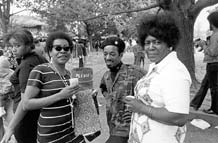
http://www.itvs.org/search/ataglance.htm?showID=143
http://pps.org/topics/design/AustinAllen
The
city parks of Columbus, New Orleans, Detroit, Oakland and Montgomery,
and the African-Americans who frequent them, are the subjects
of this urban documentary. Public spaces, and the ways in which
we use them, sometimes conflict with official city planning.
"...a
celebration of black culture, the sort of positive portrait
that blacks deserve and seldom receive...a compelling, thoroughly
researched production."
- Frank Gabrenya, Columbus Dispatch
"Austin
Allen's documentary takes a controversial stance: that African
Americans' conception of open space is different from that of
the mostly white civic authorities who have closed public parks
in recent years, denying blacks a vital gathering place... In
building his case, Allen...creates a fascinating history of
black America."
- The East Bay Express
"In
making CLAIMING OPEN SPACES, Allen isn't looking for popularity.
He's looking for answers."
- Dennis Toth, Columbus Guardian
|
|
Coal
Bucket Outlaw, Tom Hansell
2002, 26:40
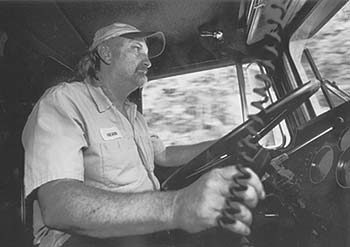
http://www.appalshop.org/film/coalbucket/
The U.S. Department of Energy reports that coal produces over
half of our nation's electricity. Coal Bucket Outlaw is built
around a day in the life of a Kentucky coal truck driver. This
digital documentary gives Americans a direct look at where our
energy comes from, and reveals the human and environmental price
we pay for our national addiction to fossil fuels.
The narrative line follows two Kentucky coal truck drivers as
they chase their version of the American dream. Viewers learn
how the economics of the coal business demand that both drivers
break the law every day. A veteran independent trucker plays the
"cops and robbers" game with the weight crew from the Department
of Transportation. A young driver debates whether to keep hauling
coal or to move his family to the city. And, a father describes
a collision with a coal truck that killed his teenage son. Facts
and figures about coal as an energy source will place these individual
struggles in a national context.
Coal
Bucket Outlaw examines the connection between coal haulers and
the larger system that produces America's electricity. If outlaws
deliver half of our nations energy, are consumers and policymakers
completely innocent?
|
|
Confederation
Park, Bill Brown
1997, 31:00, b&w

In
this mix of travelogue, essay and ironic diary, filmmaker Bill
Brown explores the political and geographical boundaries that
separate English- and French-speaking Canadians. As memories dim
of the separatist terrorist bombings that shattered Canada's peace
during the 1960s and 1970s, Brown wonders about what exactly holds
a country together.
Part
travelogue, part meditation, part monologue, Brown's films are
fascinating collages of striking images and wildly varying observations
about the places he visits. In films like the recent Confederation
Park (winner of numerous film-festival awards), Brown is audacious
enough to tackle a subject as broad as Canadian nationhood, yet
he's also smart enough to find answers in a place's tiny details,
eccentricities and ambiguities. As Brown's voice-over narration
contemplates separatist violence in Quebec, or bland urban renewal
in Montreal, or earthquake preparations in Vancouver (sounding
all the while like a grad student on pot), his camera captures
the desolation and beauty of each locale: A neon sign flashes
at sunset on an empty street. Children intrepidly play miniature
golf on a course chiseled out of ice. A kitten scurries across
the street before an oblivious oncoming sedan. "The most amazing
thing about Bill's work is his really patient photography," says
McCormick. "He reminds me of Ansel Adams camping out for a week
to find the best light."
http://atlanta.creativeloafing.com/2002-06-26/flicks_review.html
"In
the voice-over to his most recent film, CONFEDERATION PARK, Texas
filmmaker Bill Brown makes reference to 'the secret languages
of exile,' and while this reflective, even somber film presents
a pastiche of places across Canada where Brown has lived, its
real subject is the limits of knowledge. Its long takes are accompanied
by verbal meditation on the nation's recent history, including
the separatist bombings in Quebec during the 60s, and the battle
between English and French becomes a metaphor for the filmmaker's
divided mind. Brown applies stickers with city names to a huge
outdoor map of Canada, his voice-over suggesting that 'we've found
our place in the universe' as a result of the 'Copernican revolution'
- but then the stickers are blown away by the wind. Brown implies
that images are insufficient: we need to know their history, their
locations, their meaning. But landscapes can't be fully decoded,
nor past events captured on film: in the final shot a woman sings,
'I don't know where he's headin' for,' while a car travels in
a circle." --Fred Camper, Chicago Reader
http://www.rodeofilmco.com/peripheralproduce/brown/events.html
|
|
Confirmation
of My Sins, Zachery Longboy
1995, 12:00
http://www.nativeonline.com/zachary.htm
|
|
(The)
Cow Jumped Over the Moon, Christopher Walker
1999, 52:00
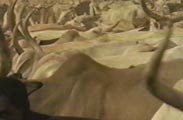
http://www.scdff.org/programs/oct_3/index.html
For
the Fulani nomads of Mali, cattle are the lifeblood. After many
years of drought, however, lack of pasture and water threatens
the herd's existence. Now, advanced satellite technology is being
used to help them survive. The Cow Jumped Over the Moon documents
the interaction between the pastoral knowledge of the West African
herders and the technological knowledge of U.S. scientists working
in agencies such as NASA and NOAA (the National Oceanographic
and Atmospheric Agency).
This
fascinating film explores the consequences of drought on the Fulani
herders who, for many years, have followed traditional migration
routes from the edge of the Sahara to the Niger River delta in
search of pasture. Now, competition from rice farmers means that
pasture is no longer available, or only at a steep price. The
film focuses on a community that must abandon their village in
search of water - but can no longer depend on their ancestors'
migration routes to guide them.
Meanwhile,
in Dakar, Senegal, scientists download satellite images that indicate
sources of water and pasture in the region. At Lockheed-Martin
and NASA's Goddard Space Center, scientists explain the technology
and the theory behind this ambitious program. However, Wolfgang
Sachs, a prominent German environmentalist, is critical of this
data-generated approach, seeing it as an extension of U.S. efforts
to control the earth in the name of saving the environment.
The
Cow Jumped Over the Moon poses important questions about knowledge
and technology, autonomy and conformity, and the role of locality
in an age of globalization. It asks whether it is possible to
create a fusion between learning from experience and employing
outside expertise as a means of managing the environment.
|
|
Crossroads,
Bruce Conner
1976, 36:00, 16mm, b&w/so
Original music by Patrick Gleeson and Terry Riley.
"Conner
bases his film on government footage of the first underwater A-bomb
test, July 25, 1946, at Bikini Atoll in the Pacific. Recorded
at speeds ranging from normal to super slow motion, the same explosion
is seen 27 different times - from the air, from boats and land-based
cameras; distant and close-up. The opening segment emphasizes
the awesome grandeur of the explosion - the destructiveness, as
well as the dramatic spectacle and beauty. As the repetition builds,
however, the explosion is gradually removed from the realm of
historic phenomena, assuming the dimensions of a universal, cosmic
force. And in the film's second section this force is brought
into a kind of cosmic harmony, part of the lyrically indifferent
ebb and flow of life that one sees in a lingering, elegaic view
of the ocean." - Thomas Albright, San Francisco Chronicle
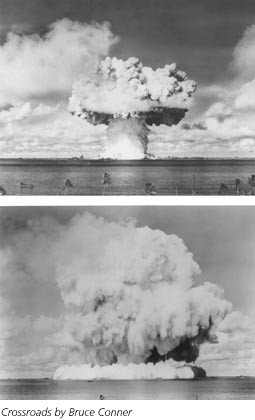
|
|
Daughters
of the Dust, Julie Dash
1992, 112:00
In
the winter of 1992, nearly one hundred years after motion pictures
were invented, the first nationally distributed feature by an
African American woman was released in the United States. The
film tells the story of an African American sea-island family
preparing to come to the mainland at the turn of the century.
In her richly textured, highly visual, lyrical portrayal of the
day of the departure, Julie Dash evokes the details of a persisting
African culture and the tensions between tradition and assimilation.
Daughters of the Dust: The Making of an African American Woman's
Film, which includes Dash's complete screenplay, describes the
story of her extraordinary sixteen-year struggle to complete the
project.
http://geechee.tv/julieinfo/bio2.html
http://geechee.tv/index1.html
http://www.kino.com/video/item.php?film_id=78
|
|
Départ
(Departure), Thomas Comerford
2000, 6:00, 16mm sound, color
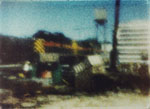
In
French w/English subtitles. The landscape of a railroad switchyard
in a small Midwestern town and the relationship a French filmmaker
has with the railroad. As an homage to Louis Lumiére's Arrivée
and early cinema, the film feels nostalgia for the mechanical,
intertwined institutions of railroad and cinema. Part of the "Cinema
Obscura" series.
|
|
Deseret,
James Benning
1995, 82:00, 16mm, b&w/color/so
"James
Benning marks the centennial of Utah's statehood with his excellent
experimental documentary, DESERET. As befits its structuralist
maker, the film examines the imposition of human design, both
physical and conceptual, on nature. A chain of beautiful, static
shots frame details of Utah's landscapes, from windswept waters,
to snowy pines, to immobile oil derricks and silent government
buildings. Meanwhile, texts from the New York Times describing
the state's social history, 1852 to the present, are read in voice
over. Just as the terrain is contained within human constructs
- Indian paints mark rocks, graffiti mark the Indian paintings,
the graffiti are enclosed in the filmmaker's frame - the state's
human inhabitants are circumscribed by the stringent codes of
Brigham Young and his burgeoning Mormon sect - fascinatingly described
in the Times pieces - and that group's resistance to outside control
and interference. (DESERET was the people's original choice, rejected
by Washington, for the state's name.) Benning imposes his own
strictly defined filmic formula, and it's that intriguing complicity
that gives DESERET the authority to transcend mere prettiness.
..." - Hazel-Dawn Dumpert, LA Weekly
http://www.chireader.com/movies/archives/0396/03156.html
|
|
(The)
Devil Never Sleeps (EI Diablo Nunca Duerme), Lourdes Portillo
1994, 82:00
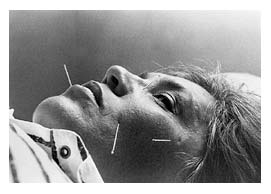
http://www.lourdesportillo.com/flmdevil.html
http://www.wmm.com/Catalog/pages/c420.htm
http://www.utexas.edu/utpress/excerpts/exfrelou.html
With
The Devil Never Sleeps/EI Diablo Nunca Duerme, Lourdes Portillo
continues her ground-breaking work, this time mining the complicated
intersections of analysis and autobiography, evidence and hypothesis,
even melodrama and police procedural. Her unorthodox means of
exploring the subject here include the use of clips from television
soap operas, 8mm home movies, archival footage, family photographs,
and stylized visual reminiscences.
Early
one Sunday morning in July, the filmmaker receives a phone call
informing her that her beloved Tio (uncle) Oscar Ruiz Almeida
has been found dead of a gunshot wound to the head in Chihuahua,
Mexico. His widow has declared his death a suicide. Most of his
family, however, cry murder and point to a number of possible
suspects: his business partner, his ranch-hand, the widow herself.
In
The Devil Never Sleeps, Portillo returns to the land of her birth
to find out exactly who her uncle was and to investigate the circumstances
of his death. She explores "irrational" as well as "logical"
explanations, searching for clues on both sides of the border
and in the history of her family. Old tales of betrayal, passion,
lust and supernatural visitation emerge as we follow thefilmmaker
deep into the life of a community in the homeland of PanchoVilla.
The Devil Never Sleeps exposes the loves and hatreds of a Mexican
family convulsed by the death of one of its members. The emotions
which Portillo captures in her particular blend of traditional
and experimental techniques bring out the nuances of Mexican social
and family order. Poetic, tragic, humorous and mythic, this film
crosses the borders of personal values, cultural mores and the
discipline of filmmaking itself.
Tio
Oscar's death revives in Portillo the resonances of her early
upbringing and ancestry; the film works both as an exciting "documystery"
and as a lyrical account of a personal journey. It uncovers Portillo's
feelings for Mexico as she invites the viewer to accompany her
to a place beyond fact or fiction, where truth is stranger than
any telenovela (Mexican soap opera) and where, as they say in
Northern Mexico when evil is lurking, the devil never sleeps!
|
|
Drift,
Chris Welsby
1995, 17:00, 16mm, color/so
Location: Vancouver, Canada

The overall feel of DRIFT is sombre and mysterious; a study of
winter light falling on the surface of water, metal and cloud.
The dominant colour is grey; grey infused with a multitude of
ocean blues and greens. There is little land in this film and
very few landmarks from which to navigate from one space to the
next. The picture plane is in continuous motion like the ocean
which, on the surface at lest, is the subject of DRIFT.
|
|
Fast,
Cheap & Out of Control, Errol Morris
1997, 82:00
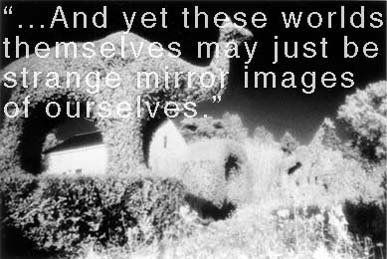
"Fast,
Cheap & Out of Control" may be Errol Morris' most unusual work
yet. Morris himself calls it "the ultimate low-concept movie--a
film that utterly resists the possibility of a one-line summary,"
The film interweaves the stories of four obsessive men, each driven
to create eccentric worlds of their dreams, all involving animals:
Dave Hoover, a lion tamer who idolizes the late Clyde Beatty,
and who shares his theories on the mind of wild animals; George
Mendonça, a topiary gardener who has devoted a lifetime to painstakingly
shaping bears and giraffes out of hedges and trees; Ray Mendez,
who is fascinated with hairless mole-rats, tiny buck-toothed mammals
who behave like insects; and Rodney Brooks, an M.I.T. scientist
who has designed complex, autonomous robots that can crawl like
bugs without specific instructions from a human controller. As
the film proceeds, thematic connections between the four protagonists
begin to emerge. The lion tamer and the topiary gardener look
back at ways of life which are slowly disappearing; the mole-rat
specialist and the robot scientist eye the future, envisioning
creatures that may someday replace the human race.
The film's style is as adventurous as its subject matter. Working
with Oscar-winning cinematographer Robert Richardson ("Natural
Born Killers," "Casino"), Morris utilizes numerous film formats
and resolutions--including black & white, color, 35mm, l6mm, Super
8 and video, as well as stock footage, old movies and cartoons--to
create a singularly impressionistic collage of images. Morris'
trademark unblinking interviews were shot with his invention,
the Interrotron, which allows his subjects to look directly into
the camera lens and, at the same time, have eye contact (through
an image projected on a teleprompter) with Morris. The film's
unique vision is echoed by Caleb Sampson's haunting and powerful
score.
Hilarious, sad, absurd, eerie and beautiful, "Fast, Cheap & Out
of Control" is a film like no other. Starting as a darkly funny
contemplation of the Sisyphus-like nature of human striving, it
ultimately becomes a profoundly moving meditation on the very
nature of existence.
http://errolmorris.com/main.php
|
|
Fey
Eyes Pin Holes Drums Hum, Thomas Comerford
1999, 14:00, 16mm sound, color
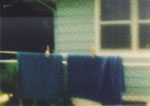
Supported,
in part, by a University of Iowa Fine Arts Council Grant. This
new cinema is created with a pinhole camera and found/homemade
noise machines. The film examines landscapes and obsolescence.
Part of the "Cinema Obscura" series.
"[the
film's] diverse, soft-focus landscapes have a haunting and weirdly-distanced
virtuality." --Fred Camper, Chicago Reader
http://home.earthlink.net/~tcomerfordil/film.html
|
|
Figures
in the Landscape, Thomas Comerford
2002, 11:00, 16mm
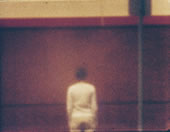
This
pinhole film examines the relationship of the human figure to
the "new" suburban, monumental sprawl landscapes of
Schaumburg, IL. Found texts provide local (yet generally North
American) stories of both human interaction with the landscape
and ideas of land development. Part of a series of films made
with pinhole cameras and found/homemade noise machines. Supported,
in part, by a Community Arts Assistance Program Grant from the
City of Chicago Department of Cultural Affairs.
http://home.earthlink.net/~tcomerfordil/film.html
|
|
(A)
Final Season, Adam Matalon
2003, 53:00
http://www.chatsbyfilms.com/
http://www.chatsbyfilms.com/afsnarrative.html
http://www.mediarights.org/search/fil_detail.php?fil_id=06002
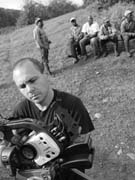
A
Final Season is a powerful examination of the tidal force of economic
globalization. It is an intimate and touching portrait of Russell
Holze, a veteran Hudson Valley Apple grower, and a disparate band
of Jamaican laborers, who, for twenty years, have made the long
trek north each year to tend apple orchards in the Hudson Valley.
The
mutually beneficial bonds that these men share are under siege.
This year, as the economics become untenable and the weather batters
apple farmers across the Hudson Valley, Russell will retire and
a wave of change will embrace Russell, the Jamaicans, and the
entire Hudson Valley's apple industry. A Final Season captures
the personal stories of these men, and investigates the continuing
viability of the governments H-2A Temporary Immigrant Labor Program;
providing us all with a powerful microcosm in the shifting sands
of this new world economy.
|
|
Fixin'
To Tell About Jack, Elizabeth Barret
1975, 25:00, Color
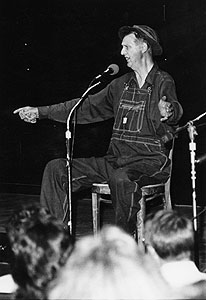
"And
the man came up the next morning, expecting to bury Jack. And
Jack was a-singing in there, and told him then it was six little
black devils come out on him. He said, 'Over there they is in
the sack.' And the man peeked in at them and said, 'Well, them
scandals! With all the trouble they give me, I won't be satisfied
until I see them beat up on a anvil.'...They told the blacksmith
man that they wanted him to beat them up. And they said when he
begin to beat them on the anvil, they's so many sparks flew out
of it, it set the blacksmith shop afire and burned it down." -Ray
Hicks telling "Whickety-Whack Into My Sack"
Ray Hicks is a mountain farmer from Beech Mountain, North Carolina,
with a genius for telling traditional folktales that have been
passed down in his family for generations. This film shows Ray
working on his farm, gathering herbs in the woods, and describing
his family's tradition of storytelling and his theories of human
and natural continuity. Running throughout the film is Ray telling
a tale called "Whickity-Whack, Into My Sack" (also known as "Soldier
Jack"). The film provides a wonderful opportunity to experience
the art of this National Heritage Award winner while also reminding
us of the importance of passing things on, of tradition, of memory.
http://www.appalshop.org/film/film.php?filmid=68
http://www.appalshop.org/rayhicks/
|
|
Fog
Line, Larry Gottheim
1970, 11:00, 16mm, color/si
"It
is a small but perfect film." - Jonas Mekas
"The
metaphor in FOG LINE is so delicately positioned that I find myself
receding in many directions to discover its source: The Raw and
the Cooked? Analytic vs. Synthetic? Town & Country? Ridiculous
and Sublime? One line is scarcely adequate to the bounty which
hangs from fog & line conjoined." - Tony Conrad
"FOG
LINE is a wonderful piece of conceptual art, a stroke along that
careful line between wit and wisdom - a melody in which literally
every frame is different from every preceding frame (since the
fog is always lifting) and the various elements of the composition
- trees, animals, vegetation, sky, and, quite importantly, the
emulsion, the grain of the film itself - continue to play off
one another as do notes in a musical composition. The quality
of the light - the tonality of the image itself - adds immeasurably
to the mystery and excitement as the work unfolds, the fog lifting,
the film running through the gate, the composition static yet
the frame itself fluid, dynamic, magnificently kinetic." - Raymond
Foery
|
|
Four
Corners, James Benning
1997, 80:00, 16mm, color/so
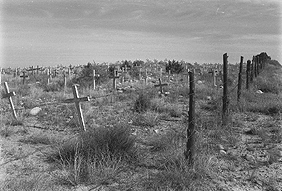
"Sometimes
dreams are wiser than waking." These words, attributed to the
Oglala Sioux medicine man Black Elk, are the final bit of text
to appear in veteran filmmaker James Benning's FOUR CORNERS which
uses a specific geographic location to pose larger questions about
the United States. Here, the geographic and wholly imaginary place
Four Corners, that favorite tourist destination where Colorado,
New Mexico, Arizona and Utah meet, becomes a kind of theoretical
ground zero, the site from which Benning can give voice to other,
pointedly unofficial sort of spurious conspiracy (the history
of the United States), but one in which each sound and each image
hints at a story not yet fully told (the histories of the United
States.)." - Manohla Dargis, LA Weekly
http://www.ufvc.org/recentshows/042800Benning/Benning4Corners.htm
|
|
From
the First People, Sarah Elder, Leonard Kamerling
1977, 45:00
This is a film about change and contemporary life in Shungnak,
a village on the Kobuk River in northwestern Alaska, 75 miles
north of the Arctic Circle. Life in this inland community is dominated
by the seasons and the river. In October, when the film begins,
the Kobuk becomes filled with ice, which slowly thickens until
freeze-up is complete. Traditional subsistence activities still
continue: women net fish under the ice, and a man and his wife
construct a cottonwood mudshark trap that is carefully placed
in the river ice. The combination of old and new technology is
pervasive. Some people hitch their teams of huskies to a sled,
others travel by snowmobile.
Old people reflect upon these changes. "In the old days," George
Cleveland laughs, "you knew your good dogs would get you home.
Today, if your snowmachine breaks down, you have to walk! On the
other hand," he says, "most things these days are easier than
in the past, when people had to be tough in order to survive.
Today, you just plug in the bubbling coffee pot, pull the string
for light, and turn the stove's knob when you are cold." Indeed,
popcorn is cooking on the stove as children don masks for Halloween
trick-or-treating.
The film reveals that life along the Kobuk River is still inextricably
linked to the harsh and starkly beautiful land, where the December
sun rises at 11 a.m. and sets three hours later. An old man shares
his feelings about the changes he has seen: "Long ago, forest
fires put themselves out. Today, even when men fight them, they
burn. I think our earth is getting old, and when things get old
and dry they burn. Our earth is the same way," he adds. "It's
ready to burn. I think it's coming close to the time when we will
have a new one."
American
Film Festival Blue Ribbon, Finalist
|
a - f |
g - p | q
- z
|
























